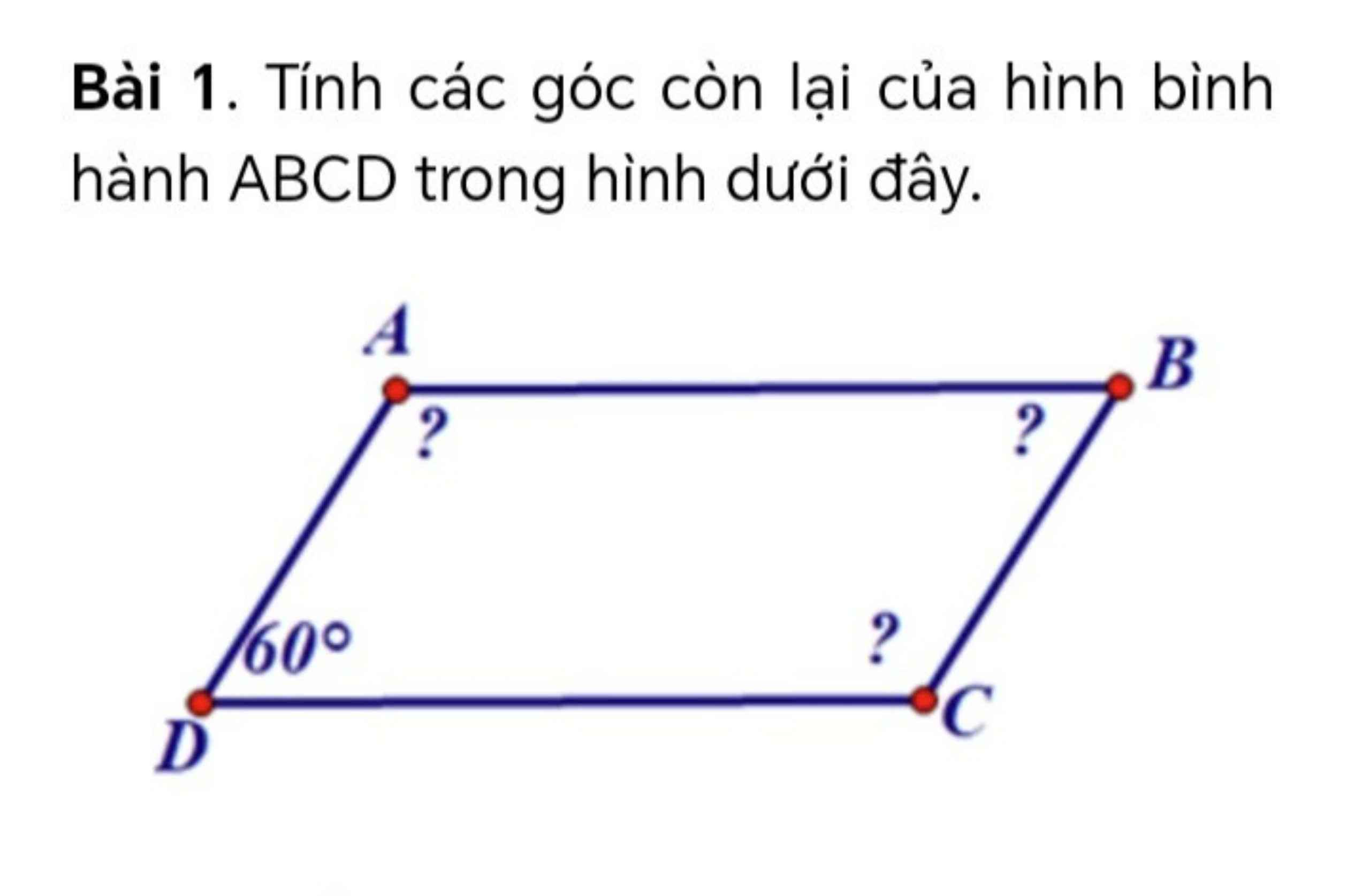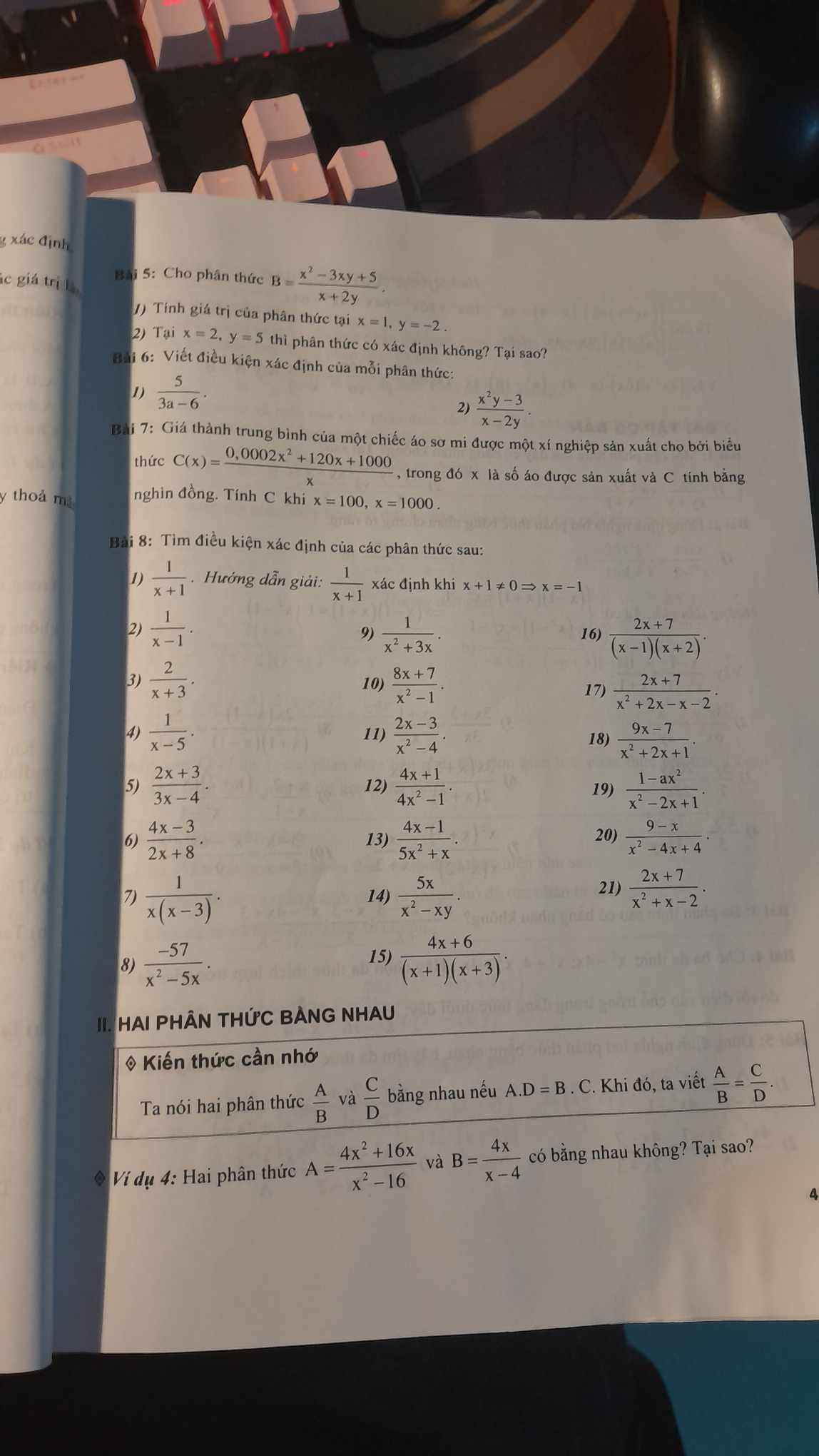
Ta có:D=B(theo định lí hình bình hành)
Do đó:B=60 độ
Mà A=C
Nên A=C=360-60+60
_________=120 độ
3
Vậy D=B=60 độ
A=C=120 độ
Đúng 1
Bình luận (1)
Tứ giác ABCD là hình bình hành.
\(\Rightarrow\)góc B=góc D(=65o)(tính chất hình bình hành)
Lại có:góc B+góc A =180o(2 góc trong cùng phía bù nhau)
\(\Rightarrow\)góc A =180o-góc B=180o-65o=115o
góc A = góc C (115o)(tính chất hình bình hành)
Đúng 1
Bình luận (0)
 giúp em với ạ bài 8 câu 2,113,15,21
giúp em với ạ bài 8 câu 2,113,15,21
Thực hiện phép tính:
a) \(\dfrac{1}{x+2}\) + \(\dfrac{3}{x^2+4}\) + \(\dfrac{x-14}{\left(x^2+4x+4\right)\left(x-2\right)}\)
b) \(\dfrac{18}{\left(x-3\right)\left(x^2-9\right)}\) - \(\dfrac{3}{x^2-6x+9}\) - \(\dfrac{x}{x^2-9}\)
Giúp e với ạ!!
a: Sửa đề: \(\dfrac{1}{x+2}+\dfrac{3}{x^2-4}+\dfrac{x-14}{\left(x^2+4x+4\right)\left(x-2\right)}\)
\(=\dfrac{1}{x+2}+\dfrac{3}{\left(x-2\right)\left(x+2\right)}+\dfrac{x-14}{\left(x+2\right)^2\cdot\left(x-2\right)}\)
\(=\dfrac{x^2-4+3\left(x+2\right)+x-14}{\left(x+2\right)^2\cdot\left(x-2\right)}\)
\(=\dfrac{x^2+x-18+3x+6}{\left(x+2\right)^2\cdot\left(x-2\right)}\)
\(=\dfrac{x^2+4x-12}{\left(x+2\right)^2\cdot\left(x-2\right)}=\dfrac{\left(x+6\right)\left(x-2\right)}{\left(x+2\right)^2\cdot\left(x-2\right)}\)
\(=\dfrac{x+6}{\left(x+2\right)^2}\)
b: \(\dfrac{18}{\left(x-3\right)\left(x^2-9\right)}-\dfrac{3}{x^2-6x+9}-\dfrac{x}{x^2-9}\)
\(=\dfrac{18}{\left(x-3\right)^2\cdot\left(x+3\right)}-\dfrac{3}{\left(x-3\right)^2}-\dfrac{x}{\left(x-3\right)\left(x+3\right)}\)
\(=\dfrac{18-3\left(x+3\right)+x\left(x-3\right)}{\left(x-3\right)^2\cdot\left(x+3\right)}\)
\(=\dfrac{18-3x-9+x^2-3x}{\left(x-3\right)^2\cdot\left(x+3\right)}\)
\(=\dfrac{x^2-6x+9}{\left(x-3\right)^2\cdot\left(x+3\right)}=\dfrac{1}{x+3}\)
Đúng 1
Bình luận (0)
\(\dfrac{\sqrt{27\left(X-5\right)^2}}{\sqrt{3}}\)

= 3|x - 5| (1)
*) Với x ≥ 5, ta có:
(1) = 3(x - 5)
*) Với x < 5, ta có:
(1) = 3(5 - x)
Đúng 0
Bình luận (0)
Thực hiện phép tính: \(\dfrac{11x}{2x-3}\) - \(\dfrac{x-18}{3-2x}\)
Giúp e với ạ
\(\dfrac{11x}{2x-3}-\dfrac{x-18}{3-2x}\)
\(=\dfrac{11x}{2x-3}+\dfrac{x-18}{2x-3}\)
\(=\dfrac{11x+x-18}{2x-3}\)
\(=\dfrac{12x-18}{2x-3}=\dfrac{6\left(2x-3\right)}{2x-3}\)
=6
Đúng 2
Bình luận (0)
Xét tứ giác AEDF có \(\widehat{AED}=\widehat{AFD}=\widehat{FAE}=90^0\)
nên AEDF là hình chữ nhật
=>AF=DE; AE=DF
Xét ΔABC vuông tại A có AH là đường cao
nên \(\dfrac{1}{AH^2}=\dfrac{1}{AB^2}+\dfrac{1}{AC^2};AH\cdot BC=AB\cdot AC\)
Xét ΔADB vuông tại D có DE là đường cao
nên \(AE\cdot AB=AD^2\)(1)
Xét ΔADC vuông tại D có DF là đường cao
nên \(AF\cdot AC=AD^2\left(2\right)\)
Từ (1),(2) suy ra \(AE\cdot AB=AF\cdot AC\)
Xét ΔABC có DE//AC
nên \(\dfrac{AE}{AB}=\dfrac{CD}{CB}\)
Xét ΔABC có DF//AB
nên \(\dfrac{AF}{AC}=\dfrac{BD}{BC}\)
\(\dfrac{AE}{AB}+\dfrac{AF}{AC}=\dfrac{BD}{CB}+\dfrac{CD}{CB}=\dfrac{BD+DC}{BC}=\dfrac{BC}{BC}=1\)
=>\(\dfrac{AE}{AB}+\dfrac{AF}{AC}\) không đổi
Đúng 1
Bình luận (0)
Phân tích đa thức thành nhân tử :a, a^2 - 4b^2b, 81( x + 7 )^2 - ( 3x + 8 )^2c, 4 - 4x + x^2 - 4y^2 - 4y - 1d, y^2 - 4xy + 4x^2 - 16e, 9x^2 - 6x + 1 - (3x)^2f, x^3 + 3x^2y + 3xy^2 + y^3 + x + yTìm x, biết :a, x^3 + 27 + ( x + 3 ).( x - 9 ) 0b, x^4 - 6x^3 + 12x^2 - 8x 0c, 36( x - 1 )^2 - 25( 2x - 1 )^2 0
Đọc tiếp
Phân tích đa thức thành nhân tử :
a, a\(^2\) - 4b\(^2\)
b, 81( x + 7 )\(^2\) - ( 3x + 8 )\(^2\)
c, 4 - 4x + x\(^2\) - 4y\(^2\) - 4y - 1
d, y\(^2\) - 4xy + 4x\(^2\) - 16
e, 9x\(^2\) - 6x + 1 - (3x)\(^2\)
f, x\(^3\) + 3x\(^2\)y + 3xy\(^2\) + y\(^3\) + x + y
Tìm x, biết :
a, x\(^3\) + 27 + ( x + 3 ).( x - 9 ) = 0
b, x\(^4\) - 6x\(^3\) + 12x\(^2\) - 8x = 0
c, 36( x - 1 )\(^2\) - 25( 2x - 1 )\(^2\) = 0
b) 81(x+ 7)² - (3x + 8)²
= [9(x + 7)]² - (3x + 8)²
= (9x + 63)² - (3x + 8)²
= (9x + 63 - 3x - 8)(9x + 63 +3x + 8)
= (6x + 55)(12x + 71)
Đúng 1
Bình luận (0)
c) 4 - 4x + x² - 4y² - 4y - 1
= (x² - 4x + 4) - (4y² + 4y + 1)
= (x - 2)² - (2y + 1)²
= (x - 2 - 2y - 1)(x - 2 + 2y + 1)
= (x - 2y - 3)(x + 2y - 1)
Đúng 0
Bình luận (0)
Xem thêm câu trả lời
B = \(x^3+\dfrac{1}{x^3}\), biết rằng \(x^2+\dfrac{1}{x^2}=7\)
\(x^2+\dfrac{1}{x^2}=7\\ \\ \\ \\ \Rightarrow x^2+2x\cdot\dfrac{1}{x}+\dfrac{1}{x^2}=7+2x\cdot\dfrac{1}{x}=9\\ \\ \\ \\ \Rightarrow\left(x+\dfrac{1}{x}\right)^2=9\\ \\ \\ \\ \Rightarrow x+\dfrac{1}{x}=\pm3\)
Trường hợp 1: \(x+\dfrac{1}{x}=3\) ta có:
\(x^3+\dfrac{1}{x^3}=\left(x^2+\dfrac{1}{x^2}\right)\left(x+\dfrac{1}{x}\right)-\left(x+\dfrac{1}{x}\right)=7\cdot3-3=18\)
Trường hợp 2: \(x+\dfrac{1}{x}=-3\) ta có:
\(x^3+\dfrac{1}{x^3}=\left(x^2+\dfrac{1}{x^2}\right)\left(x+\dfrac{1}{x}\right)-\left(x+\dfrac{1}{x}\right)=7\cdot\left(-3\right)-\left(-3\right)=-18\)
Đúng 1
Bình luận (0)
Thực hiện phép tính: \(\dfrac{2x}{x^2-2xy}\) + \(\dfrac{y}{xy-2y^2}\) + \(\dfrac{4}{x^2-4y^2}\)
Giúp e với ạ, e cảm ơn.
\(\dfrac{2x}{x^2-2xy}+\dfrac{y}{xy-2y^2}+\dfrac{4}{x^2-4y^2}\)
\(=\dfrac{2x}{x\left(x-2y\right)}+\dfrac{y}{y\left(x-2y\right)}+\dfrac{4}{\left(x-2y\right)\left(x+2y\right)}\)
\(=\dfrac{2}{x-2y}+\dfrac{1}{x-2y}+\dfrac{4}{\left(x-2y\right)\left(x+2y\right)}\)
\(=\dfrac{3}{x-2y}+\dfrac{4}{\left(x-2y\right)\left(x+2y\right)}=\dfrac{3x+6y+4}{\left(x-2y\right)\left(x+2y\right)}\)
Đúng 2
Bình luận (0)




















